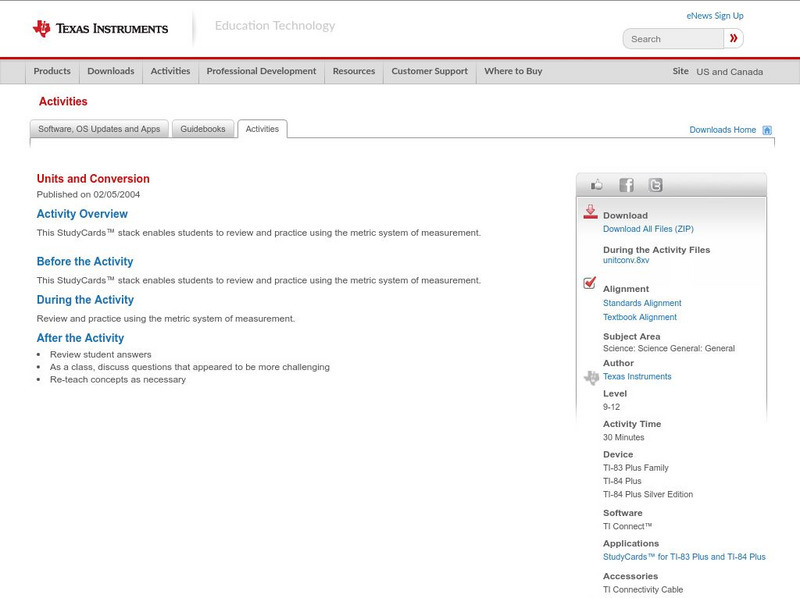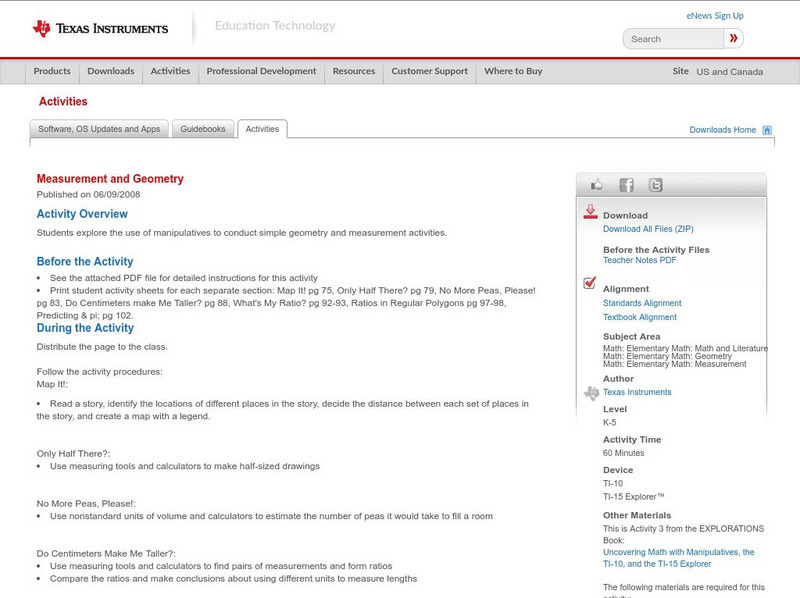Hi, what do you want to do?
Curated OER
Mapping My Pathway
Eighth graders create career portfolios, speak with the school counselor, and develop and educational plan. Individually, 8th graders discuss career options and how an educational plan can assist them in future goals. They explore...
Curated OER
Voltmeter Design
In this voltmeter activity, learners design and mathematically analyze a circuit they design. They also answer 17 questions about voltmeters, the voltage in given schematics, and the resistance in voltmeters.
Curated OER
Blues Improvisation
Students practice playing and improvising while playing the 12 bar blues. They practice compositional skills, evaluate and perform musical pieces focused on the blues.
Curated OER
Map Maker Map Maker
Students create their own maps. In this map making lesson, students go to Microsoft Word and create a chart. They label directions, buildings, streets, and distance.
Curated OER
Jupiter's Weather Forecast
Students read information about Jupiter and the planet's weather. In this Jupiter weather lesson, students read information about Jupiter's weather. Students study a chart about the weather on Earth and Jupiter. Students read a weather...
Curated OER
Fractions, Equivalent Fractions and Decimals
Students relate fractions to decimals and find and compare equivalent fractions.
Curated OER
Fractions, Equivalent Fractions and Decimals
Students examine how to relate fractions to decimals and find and compare equivalent fractions.
Curated OER
Chinese Percussion Music
Pupils investigate Chinese percussion instruments and ensemble performances. They play compositions with Chinese percussion instruments such as small gongs, large gongs and drums.
Curated OER
Center and Spread
Students collect and analyze data. For this statistics lesson, students define and calculate the range, median and standard deviation. They identify reasons for a skewed distribution.
Curated OER
Celsius Tells Temperature, Too
Second graders become aware that thermometer liquids expand or contract as temperature affects them.
Alabama Learning Exchange
Researching Hurricanes with Technology
High schoolers explain the components that make up a hurricane.
Curated OER
Weather Forecasts
In this weather worksheet, students view a weekly forecast for Bradford, United Kingdom and answer short answer questions about it. Students complete 7 questions.
Curated OER
First Grade Mathematics Quiz
In this math quiz activity, student complete multiple choice problems about money, shapes, patterns, and more. Students complete 15 problems total.
Curated OER
Sound and Hearing
In this sounds worksheet, students will review how sound is created by vibrations. Students will understand what creates vibrations and how the ear receives those sound waves. This worksheet has 10 fill in the blank, 9 multiple choice, 1...
Curated OER
Weather Predictions
Fourth graders explore meteorologists. They explore symbols on a weather map and make five day forecasts.
Curated OER
Solvents
In this solvents pre-lab worksheet, high schoolers describe the difference between a polar and non-polar solvent and also the dangers associated with hexanes and iodine. This worksheet has 12 short answer questions.
Curated OER
Destruction by Earthquakes
In this earthquakes worksheet, learners review terms associated with earthquakes such as Richter scale, seismographs, and the Moho scale. This worksheet has 10 fill in the blank questions.
Curated OER
Can You Catch Your Breath?
Students apply the the scientific method to an investigation.They develop and perform a scientific procedure for determining lung capacity. In addition, they write a report to display information and share their procedures with the class.
Curated OER
Weather Words
Third graders gather together as a class and share any facts or words about the science unit "Weather Elements". They listen to the story/poem, "Listen to the Rain" and recall any weather related words from the story.
Curated OER
Heat Absorption
Students examine how heat moves from substance to another. In this heat absorption lesson students identify ways that heat is transferred and analyze data.
Curated OER
Recipe Dance/Making Duets
Students create and memorize movement phrases within a specified structure and develop duets from the solo phrases.
Texas Instruments
Texas Instruments: Units and Conversion
This StudyCards stack enables students to review and practice using the metric system of measurement.
Texas Instruments
Texas Instruments: Estimation and Precise Measurement
Students will estimate various dimensions of objects located in a classroom. After estimations are completed, students will measure objects using appropriate measuring techniques for preciseness.
Texas Instruments
Texas Instruments: Measurement and Geometry
In this activity students explore the use of manipulatives to conduct simple geometry and measurement activities.




























